Quick Reference
Painted in 1934.
Pasture of the Keach farm
Charlemont Road, Buckland, Mass.
Oil on Canvas
Landscape
Pastures, Farms
30" x 36"
The Boston Herald Bldg, May '34
Williston Academy, 1934
Concord (MA) Art Association, '34
Binghampton (NY) MFA, 1934
Macbeth Galleries (NYC), 1935
Jordan March Galleries, 1935
Deerfield Academy, 1935
Vose Gallery, Boston, 1935 -'36
Mr. and Mrs. Alfred P. Lowell
NA
Related Links
- See also the...
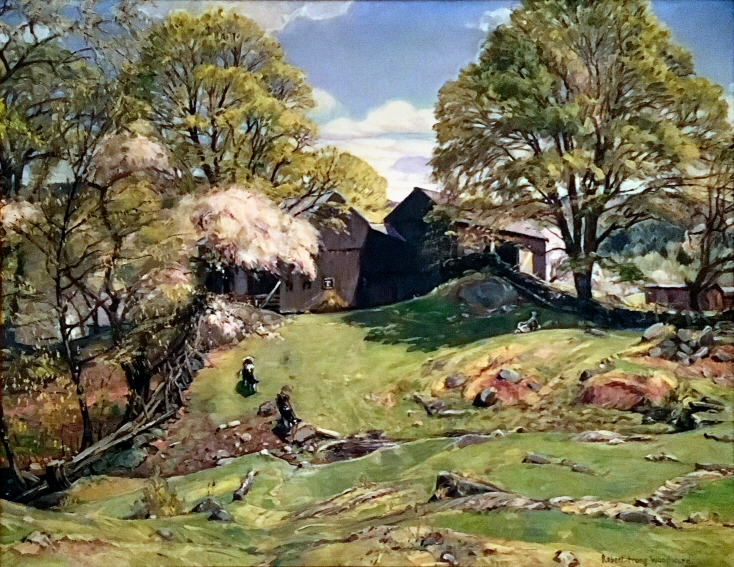 Pastures Gallery to view artwork.
Pastures Gallery to view artwork.
- See also the...
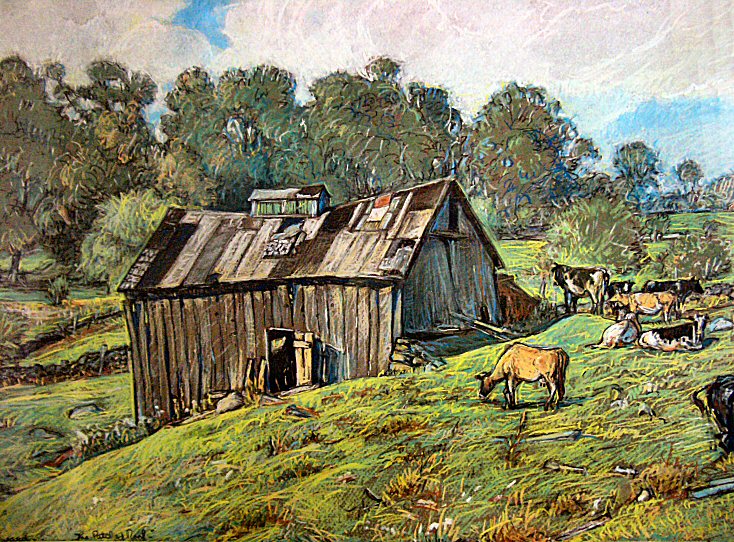 People & Livestock Gallery for related pieces.
People & Livestock Gallery for related pieces.
- See also the...
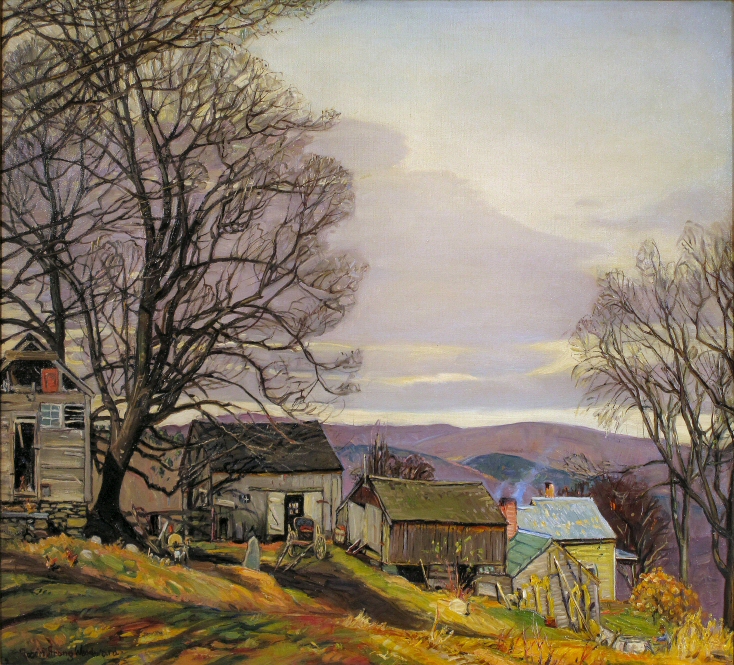 Keach Gallery to view related pieces.
Keach Gallery to view related pieces.
- See also the...
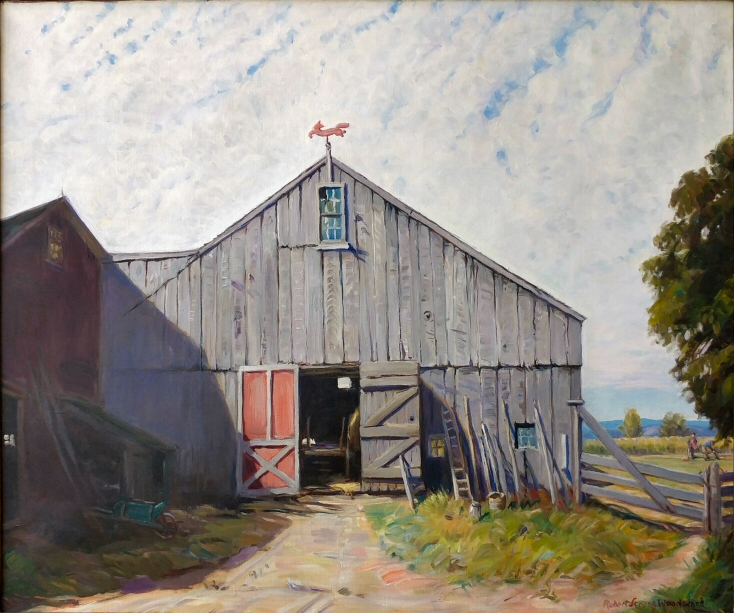 Fences, Gates & Doors Gallery to view related pieces.
Fences, Gates & Doors Gallery to view related pieces.
- See also the...
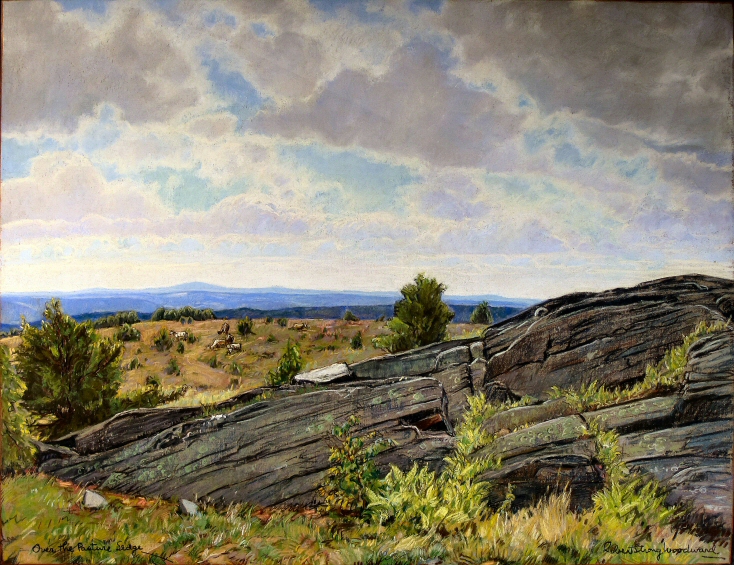 Rocks & Stone Walls Gallery to view related pieces.
Rocks & Stone Walls Gallery to view related pieces.
- See also the...
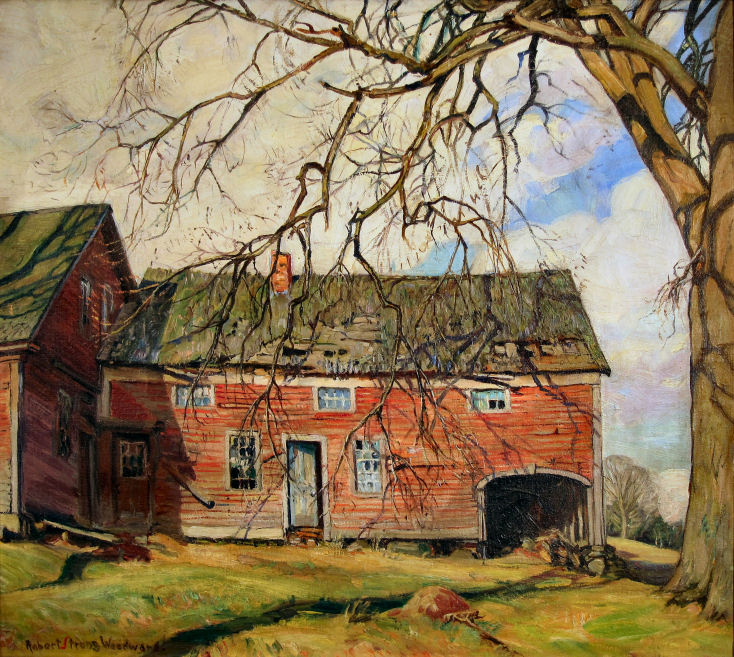 Halifax House Gallery to view related pieces.
Halifax House Gallery to view related pieces.
- See also the...
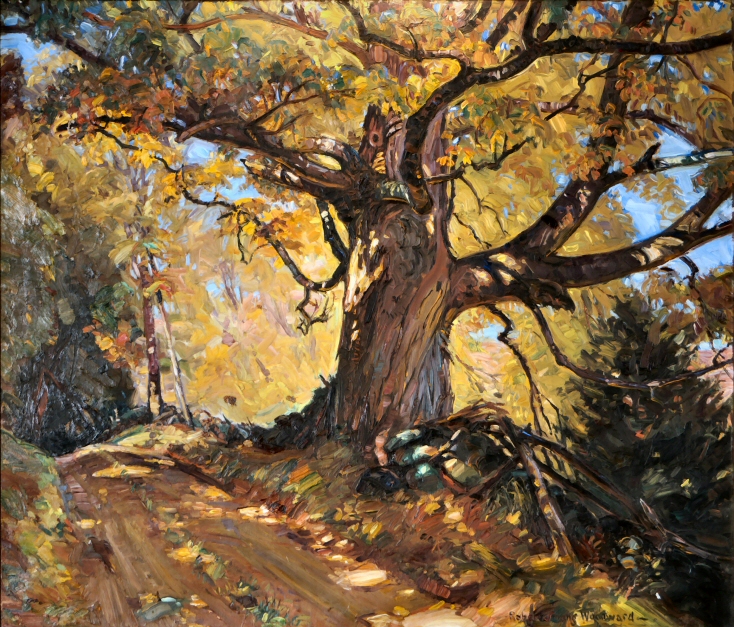 Trees Gallery to view related pieces.
Trees Gallery to view related pieces.
- See our page devoted to ...
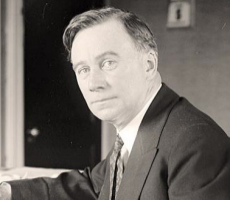 commission sponsor Francis Garvin
commission sponsor Francis Garvin
- See our page devoted to ...
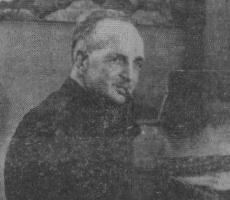 artist/friend Stanley Wingate Woodward
artist/friend Stanley Wingate Woodward
- See also the...
180.png) Award Winners Gallery to view related pieces.
Award Winners Gallery to view related pieces.
- See our list of...
 Awards RSW earned in his career
Awards RSW earned in his career
- See our page devoted to ...
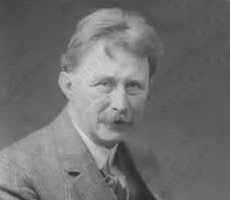 Colrain artist and RSW ally George Gardner Symons
Colrain artist and RSW ally George Gardner Symons
Featured Artwork: From a May Pasture
RSW's Diary Comments
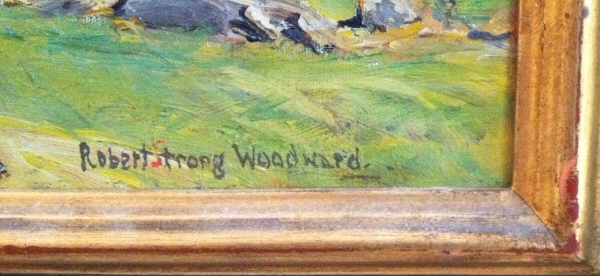
 A close up picture of RSW's signature
A close up picture of RSW's signature
"Painted in 1934. Painted from Keach's pasture of
their twin barns, the last spring before my fire, for Mr. Bowlen of Roger, Bowlen and Lunt, at his
request, but he died just as the canvas was finished and to everyone's surprise his widow and
family refused to honor the order. One of the finest of my paintings, to my mind; was generally
exhibited and illustrated and finally bought by Mr. and Mrs. Alfred P. Lowell of 64 Mt. Vernon St.,
Boston---from my exhibition at the Vose Galleries, Boston, Mass. "$600 less 25%= $450"
Clipping from the Boston Herald, August 26, 1934
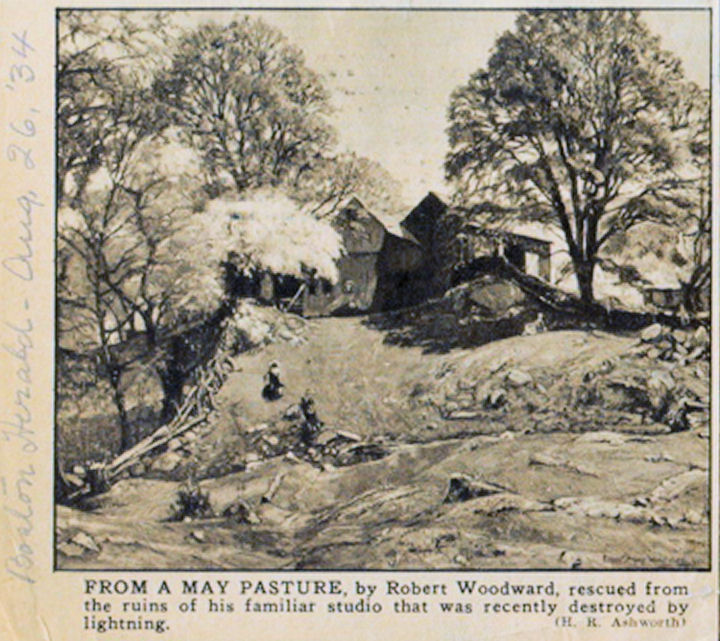
 Note that this clipping in the Boston Herald
Note that this clipping in the Boston Herald
appears just months after the painting hung in
the Herald's headquarters in Boston.
Comments on the back of a sepia print:
"Fine, solid modeling of foreground, so you feel and sense the rocky earth."
"This is the painting I made in May, by
the direct request of Mr. William Bowlen of Holyoke, who suddenly died while it was still fresh on
the easel before he ever saw it. It has been hoped, up to just within a day or two, that his widow,
Mrs. Bowlen, would still purchase it. She admires it, with great intensity---but last Saturday, to
my deepest disappointment, she came to the studio returning the painting. (She had asked to have it
come to her home from Easthampton,) saying that until the estate was settled, she dared not spend the
$750---although that was the price that Mr. Bowlen had agreed to pay for it. It is unquestionably
one of the finest pieces of painting I have done. The photograph looks rather dull and heavy, whereas
it is subtle with delicate spring yellows, and pinks and early green, with a lucid brilliant sky and
one of the finest modeled foregrounds I ever painted. One feels the rocks and construct of the earth
elements under the thin new pasture grass. Sometime I hope you see this in the original. It is 30 x
36."
Comments in a notebook by RSW:
"Sent by R. R. Express, in one crate, From a May Pasture thru J.W. McBrine,
packer, 162 Newbury Street, to go to the Jordan Marsh Company for their Annual Art Week Exhibition, held
at their Department Store. Paintings there are insured during exhibition. The exhibition is supposed to
be for one week from April 7th to 13th but every year, so far, they have kept the show over for two full
weeks."
"June 19, 1935. A crate was sent to Newport, Rhode Island, to enter an exhibition held
by the Art Association of Newport, 76 Bellevue Ave. From a May Pasture 30" x 36" (Exhibition
July 13th to August 3rd."
Additional Notes
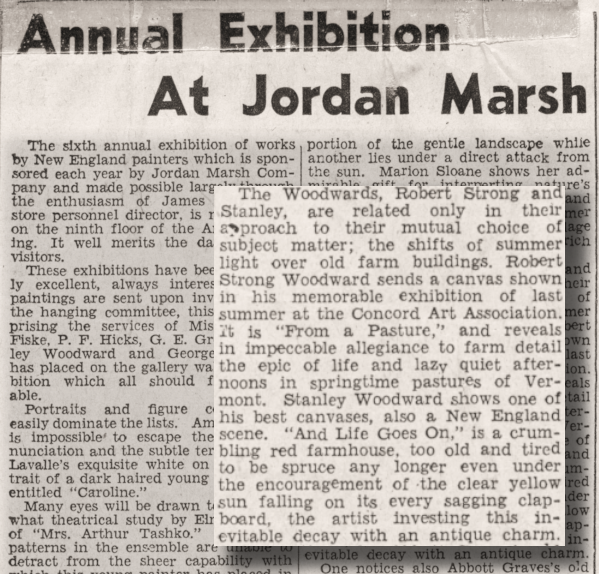
 Unsourced Clipping from 9 April, 1935
Unsourced Clipping from 9 April, 1935
 To the right: is an article that just may be the
detonator that caused quite a riff between RSW and his friend artist Stanley W. Woodward. Not only did
Stanley leave his coastal haunts around Rockport, MA, to paint Woodward's beloved Halixfax House but
when this painting AND Stanley's Halifax House painting, And Life Goes On, exhibit at the 1935
Jordan Marsh show the clipping to the left CLUMPS them together like they are brothers, and gives more
attention and praise to Stanley's Halifax House calling it "one of his best".
To the right: is an article that just may be the
detonator that caused quite a riff between RSW and his friend artist Stanley W. Woodward. Not only did
Stanley leave his coastal haunts around Rockport, MA, to paint Woodward's beloved Halixfax House but
when this painting AND Stanley's Halifax House painting, And Life Goes On, exhibit at the 1935
Jordan Marsh show the clipping to the left CLUMPS them together like they are brothers, and gives more
attention and praise to Stanley's Halifax House calling it "one of his best".
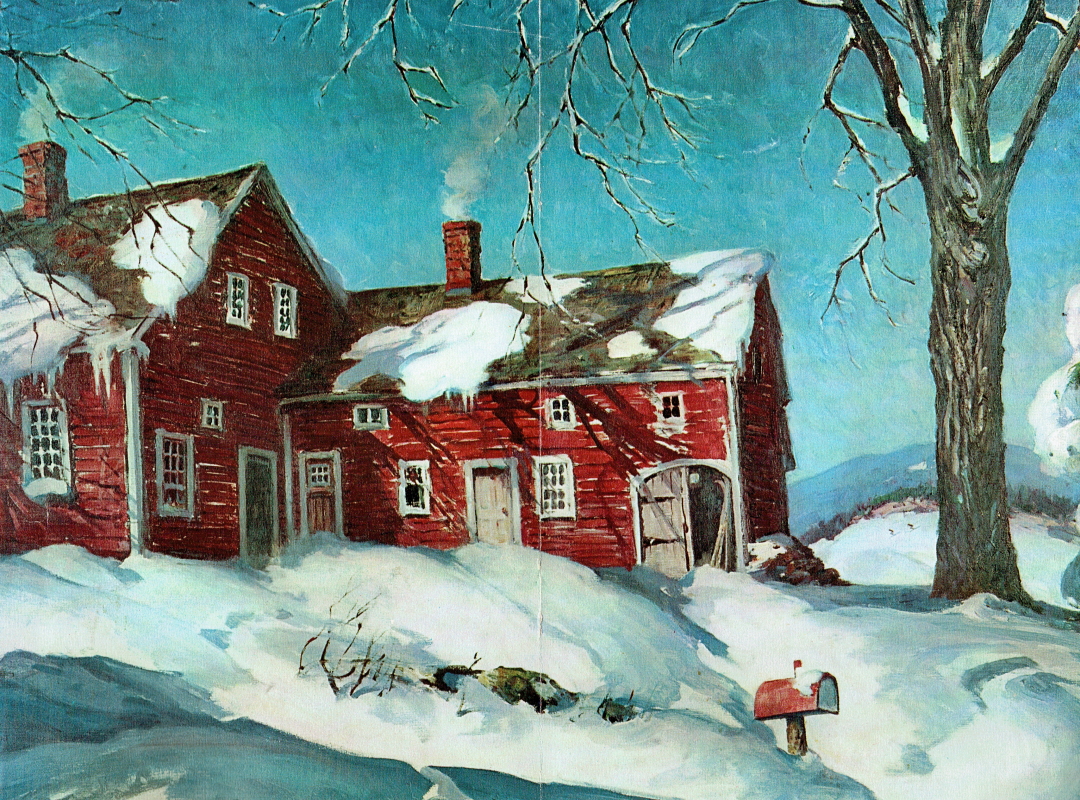
 Stanley W. Woodward's And Life Goes On, 1935
Stanley W. Woodward's And Life Goes On, 1935
New York Herald Tribune's Sunday mag. 6 April, 1940
Excerpt from the article:
"The Woodwards, Robert
Strong and Stanley, are related only in their approach to their mutual choice of subject matter;
the shifts of summer light over old farm buildings. Robert Strong Woodward sends a canvas shown in his
memorable exhibition of last summer at the Concord Art Association. It is 'From a May Pasture,' and
reveals in impeccable allegiance to farm detail the epic of life and lazy quiet afternoons in springtime
pastures of Vermont. Stanley Woodward shows one of his best canvases, also a New England scene.
'And Life Goes On,' is a crumbling red farmhouse, too old and tired to be spruce any longer even under
the encouragement of the clear yellow sun falling on its every sagging clapboard, the artist investing this
inevitable decay with an antique charm." [ The emphasis added is ours ]

 New England Heritage, 1932
New England Heritage, 1932  (BAC- 2nd prize)
(BAC- 2nd prize)
In a profile by the UMass Collegian in 1935, this
painting was cited to be, "His finest canvas."
There are several points to be made how this one event in 1935 in linked to other issues Woodward is having during a time of his greatest success:
1  RSW could not have been pleased to be paired with Stanley
Woodward in this particular instance, under these circumstances because of the subject of Stanley's painting
being that of the Halifax House. What are the chances this event in this article would clump the two together
as if they were practically brother. Woodward not only considers the Halifax House HIS discovery but his
winning the second prize at the 1932 Boston Art Club (BAC) annual exhibition with
New England Heritage is cited in a number of articles between '32 and 1935 as being his "painting
of note" of his career!
RSW could not have been pleased to be paired with Stanley
Woodward in this particular instance, under these circumstances because of the subject of Stanley's painting
being that of the Halifax House. What are the chances this event in this article would clump the two together
as if they were practically brother. Woodward not only considers the Halifax House HIS discovery but his
winning the second prize at the 1932 Boston Art Club (BAC) annual exhibition with
New England Heritage is cited in a number of articles between '32 and 1935 as being his "painting
of note" of his career!
2  RSW gets knocked a bit for From a May Pasture having already
had its day the previous year at Concord. It feels like a left-handed praise that is really a slight- RSW
recycled a painting from a previous exhibition. However, Stanley has a brand-spanking-new-out-of-this-world
painting, and possibly his BEST of all time. and And this is somewhat fair, if not embarrassing for RSW. The
Jordan Marsh show is a BIG deal. It kicks off what is called "Art Week in Boston." A lot of organizations
participate by having featured exhibits of work in their galleries. This is in fact the same week RSW won his
second prize award for New England Heritage at the BAC.
RSW gets knocked a bit for From a May Pasture having already
had its day the previous year at Concord. It feels like a left-handed praise that is really a slight- RSW
recycled a painting from a previous exhibition. However, Stanley has a brand-spanking-new-out-of-this-world
painting, and possibly his BEST of all time. and And this is somewhat fair, if not embarrassing for RSW. The
Jordan Marsh show is a BIG deal. It kicks off what is called "Art Week in Boston." A lot of organizations
participate by having featured exhibits of work in their galleries. This is in fact the same week RSW won his
second prize award for New England Heritage at the BAC.
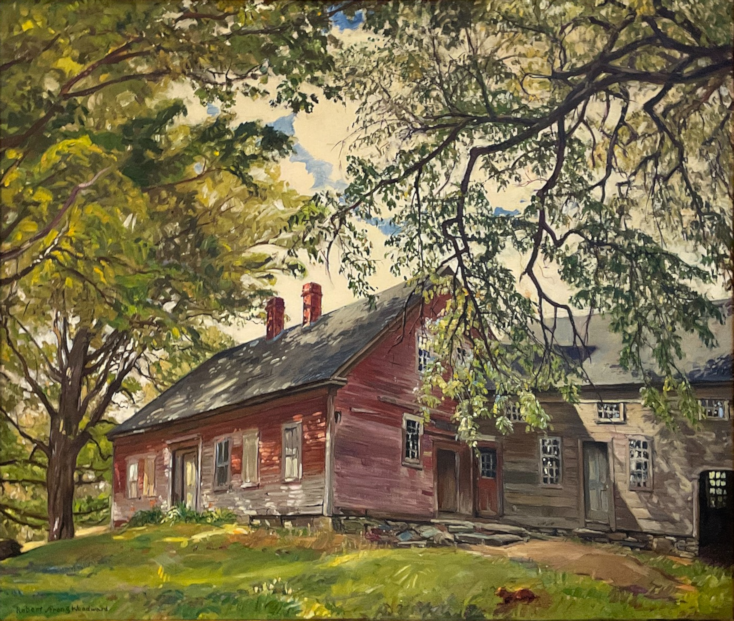
 House in Halifax, 1936
House in Halifax, 1936
Misappropriated by Yankee Magazine to accompany a
poem about the Maine Shoreline by John Schaffner III.
The magazine had the picture to go with a featured
article on RSW. The issue postponed the feature 2yrs,
3  Also, the two Woodwards gets described as painting similar scenes
and having similar interest but Stanley is learly known for his seascapes and Woodward had only ever made one
in his career and it was a gift to a family who hosted him at their place on Oyster Bay in the cape. Stanley
even wrote two books on the subject of "marine painting" and is considered among the leading artist of the
Rockport (MA) School along with Andrew Theime.
Also, the two Woodwards gets described as painting similar scenes
and having similar interest but Stanley is learly known for his seascapes and Woodward had only ever made one
in his career and it was a gift to a family who hosted him at their place on Oyster Bay in the cape. Stanley
even wrote two books on the subject of "marine painting" and is considered among the leading artist of the
Rockport (MA) School along with Andrew Theime.
4  This is the first real serious incident of another artist encroaching
on RSW's particular brand. Next would be artist John Whorf's apparent plagiarism of RSW's celebrated painting,
Country Piazza in 1938 and Yankee Magazine's misappropriation of his
painting of the Halifax House (on the left) by linking it to the Maine shoreline the same year.
This is the first real serious incident of another artist encroaching
on RSW's particular brand. Next would be artist John Whorf's apparent plagiarism of RSW's celebrated painting,
Country Piazza in 1938 and Yankee Magazine's misappropriation of his
painting of the Halifax House (on the left) by linking it to the Maine shoreline the same year.
5  There is also a link between From a May Pasture's buyer dying
before completion of the painting and the sudden death of Francis P. Garvan
who commissioned RSW to make a series of historic and architecturally significant churches to be given to the Yale
University Art Museum as part of the Mabel B. Garvan Collection of early American crafts, furnishing, and home
decor. Mrs. Garvan also did not honor the contact leaving RSW on the hook for 4 completed paitings, and several
others in various stages of completion in 1937.
There is also a link between From a May Pasture's buyer dying
before completion of the painting and the sudden death of Francis P. Garvan
who commissioned RSW to make a series of historic and architecturally significant churches to be given to the Yale
University Art Museum as part of the Mabel B. Garvan Collection of early American crafts, furnishing, and home
decor. Mrs. Garvan also did not honor the contact leaving RSW on the hook for 4 completed paitings, and several
others in various stages of completion in 1937.
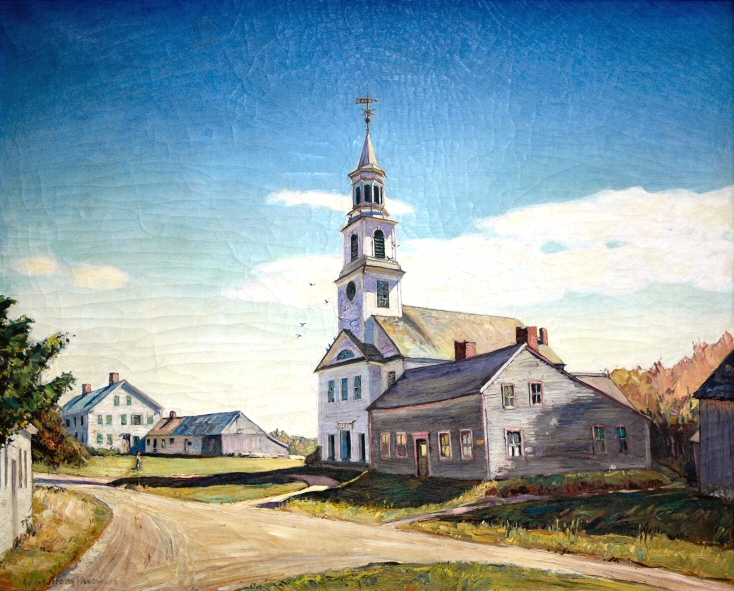
 Enduring New England, 1931
Enduring New England, 1931
The ONLY painting to make it into the Garvan Collection
6  Stanley Woodward's intrusion
into RSW's area, and what RSW considered his brand also links to a story we are working on regarding churches as it
relates to this painting and brand in general. Many link RSW to the typical "New England Village and Church" but it
is really the village itself, not the church. Find us a village center without a church in New England? You won't
because there isn't any. Woodward became linked to the New England Church scene through a twist of fate when the
year after he painted Enduring New England the early period church
tragically burned and the architect hired to rebuild the new church saw Enduring New England hanging in
Macbeth Galleries in NYC and asked if he could use the painting to create the new design. This then led to RSW meeting
Francis P. Garvan and the Garvan Commission. Other than the Mary
Lyon Church down the street from his last studio, RSW did not feature any other church in any of his work. It is the
village center of Buckland but also, named after the town's most famous resident, educator Mary Lyon, founder of Mount
Holyoke College. The Garvan church paintings all went unsold, we believe, because he did not want to be associated
specifically painting churches.
Stanley Woodward's intrusion
into RSW's area, and what RSW considered his brand also links to a story we are working on regarding churches as it
relates to this painting and brand in general. Many link RSW to the typical "New England Village and Church" but it
is really the village itself, not the church. Find us a village center without a church in New England? You won't
because there isn't any. Woodward became linked to the New England Church scene through a twist of fate when the
year after he painted Enduring New England the early period church
tragically burned and the architect hired to rebuild the new church saw Enduring New England hanging in
Macbeth Galleries in NYC and asked if he could use the painting to create the new design. This then led to RSW meeting
Francis P. Garvan and the Garvan Commission. Other than the Mary
Lyon Church down the street from his last studio, RSW did not feature any other church in any of his work. It is the
village center of Buckland but also, named after the town's most famous resident, educator Mary Lyon, founder of Mount
Holyoke College. The Garvan church paintings all went unsold, we believe, because he did not want to be associated
specifically painting churches.
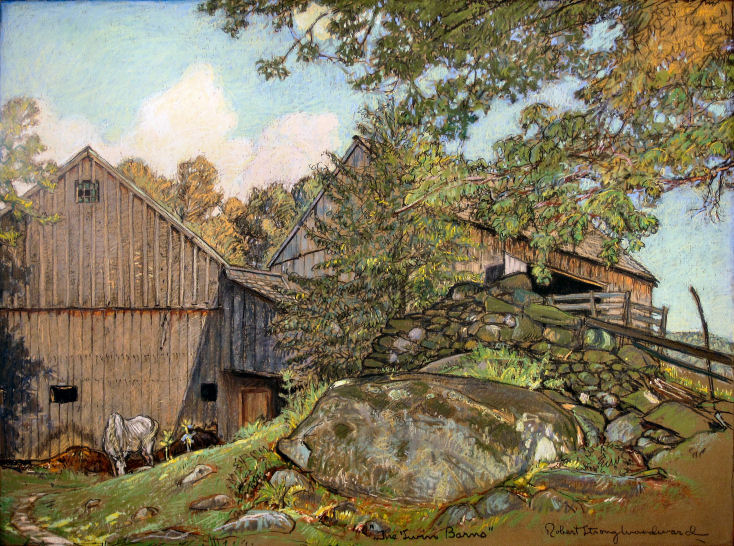
 Twin Barns, 1931
Twin Barns, 1931
A chalk drawing from the same pasture as From a May
Pasture gives a closer view of the two barns. It is im-
portant to note that 1934 is around the time RSW stops
painting from the Keach farm. The reason is unknown.
From a May Pasture may be the last one.
While we are sure Woodward's had some hurt feelings and his pride most likely piqued by the incident, him and Stanley made up sometime afterwards. Dr. Mark, the website's founder and Woodward beneficiary, writes how the two artist would paint together, even at the Heath Pasture property on Burnt Hill (Woodward's most personal of places). When Stanley went off to serve in WWII, Woodward insisted Mark visit him when he served in the Army Air Corps. The uncomfortable meeting is wonderfully told by Dr. Mark in his own words through the following link. CLICK HERE
One final say on the matter of this painting's journey. While Woodward claimed in his diary comments, "One of the finest of my paintings, to my mind;" it would seem to us that it somehow lost favor with him, that perhaps the Jordan Marsh show tainted his feelings for the painting. Of the 10 or so paintings he claims to be his favorites, he loved 8 of them so much he could let go and the two others went to close friends! This painting almost comes with relief that it is gone. After that remark, he plainly expresses, "[it] was generally exhibited and illustrated and finally bought." It is the word "finally" that grabs our attention. There is something disappointing to its tone. Is it that the buyer died before it was completed? That it took longer than expected to sell? Or is it perhaps that after the Jordan Marsh Exhibition, he was glad to finally be rid of it?
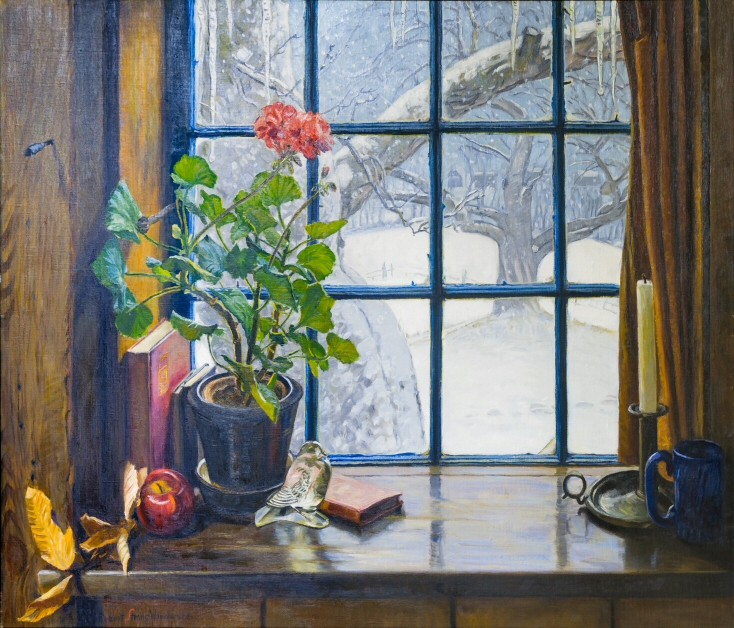
 Winter Orchard, 1946 First Prize
Winter Orchard, 1946 First Prize 
Jordan Marsh's Annual Art Week Exhibition, 1946
The Bright Side  Although Woodward's experience with this
painting, as well as the other artist mentioned, was difficult and unpleasant at the time he was living it. Its
long range impact can be seen in a much more positive light. One of the factors taken into account when trying to
establish one's legacy, whether it be in business, sports, politics, or art, especially art, it is not only how
much influence you had but WHO did you influence? In terms of legacy, Stanley Woodward and John Whorf's legacies
are considered far more significant than Woodward's presently. There isn't even a Wikipedia page for Robert! And
Wikipedia will not let us write one due to our "inherent bias." Stanley and Whorf make a number of list among
this country's "greatest" painters/artists. The Nation Gallery website once held such a list of the top 2,500
America artist and Robert Strong Woodward was not among them.
Although Woodward's experience with this
painting, as well as the other artist mentioned, was difficult and unpleasant at the time he was living it. Its
long range impact can be seen in a much more positive light. One of the factors taken into account when trying to
establish one's legacy, whether it be in business, sports, politics, or art, especially art, it is not only how
much influence you had but WHO did you influence? In terms of legacy, Stanley Woodward and John Whorf's legacies
are considered far more significant than Woodward's presently. There isn't even a Wikipedia page for Robert! And
Wikipedia will not let us write one due to our "inherent bias." Stanley and Whorf make a number of list among
this country's "greatest" painters/artists. The Nation Gallery website once held such a list of the top 2,500
America artist and Robert Strong Woodward was not among them.
However, Whorf was listed, as was Lester
Stevens (see Farmer's Castle),
Gardner Symons, and of course Stanley Wingate Woodward... another artist on the list was Anthony Thieme, who
also exhibited at Jordan Marsh and is mentioned in the article above, and who Woodward knew and bested in the
1927 Springfield Art League Annual Exhibition winning first prize for best landscape with
When Drifts Melt Fast. Thieme is considered the founder of the Rockport (MA) School to which Stanley
Woodward is included. Our Woodward won four prizes over the years at the Jordan Marsh Spring Exhibition- 1 first
overall prize (1946), and in the same year also won one of his two honorable mentions (the other was 1948),
and in 1932 won 4th place honors with New England Origins the same
week and year he took second prize at the BAC with New England Heritage. It is just something to think
about.

.png)
